Must Reads
Faced With Gender Propaganda at the Hockey Rink, One Coach Says No
Doe isn’t a “gender critical feminist,” or, indeed, any kind of professional cultural warrior. He’s just a father who refused to sign on to a propaganda document as a condition to help his son’s hockey team. And I suspect he won’t be the last.
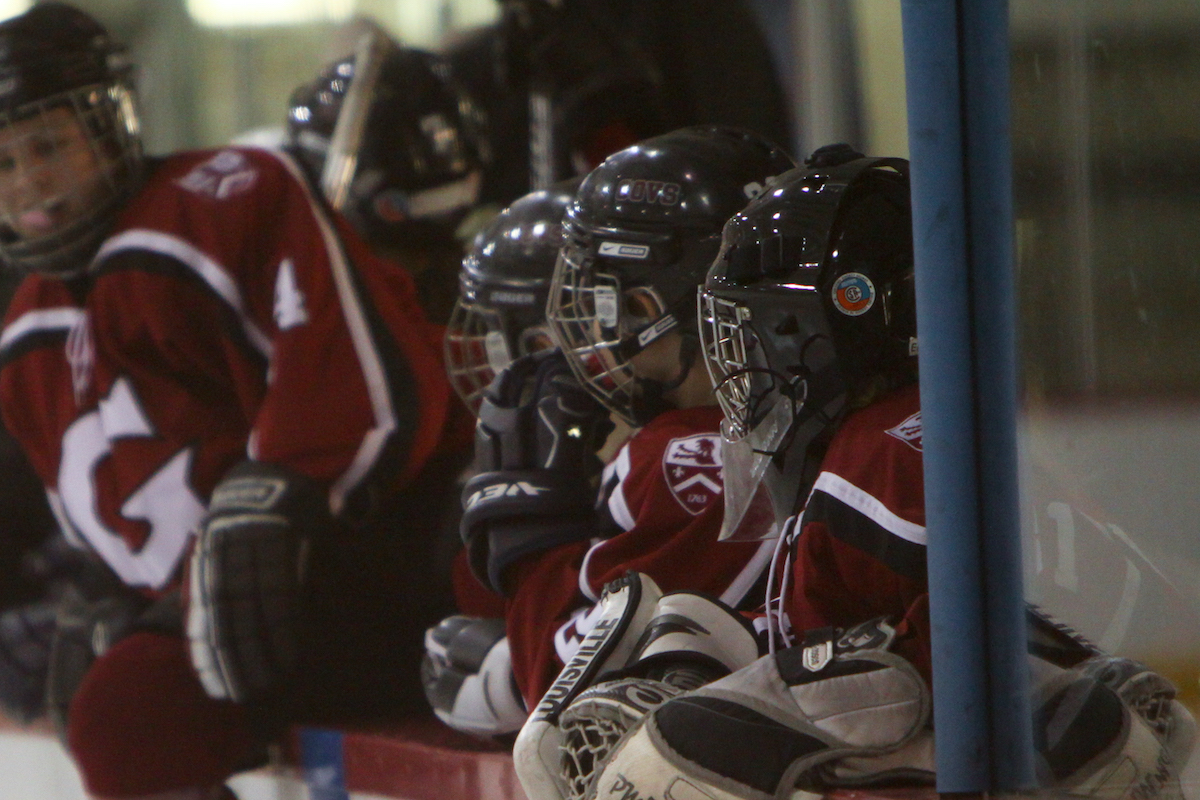
Minivans stuffed with hockey gear and parents sipping drive-thru coffee rink-side are quintessential Canadian suburban scenes. But since 2018, the world of hockey moms and dads has become just another venue for the spread of what one Ontario hockey coach describes as culture-war propaganda.
Actually, make that former coach: “I can’t coach. I can’t be on the bench. I can’t help on the ice—Even just to help on the ice, you need this training,” he explains. After having assisted on his son’s hockey team for three years, the father has been removed from all positions because he questioned the necessity of a mandatory gender identity training course imposed by Hockey Eastern Ontario (formerly the Ottawa District Hockey Association) following a 2017 legal settlement involving a transgender hockey player.
The father has been interviewed by Quillette, and supplied documentation outlining his concerns and tracking his correspondence with other parties mentioned below. These concerns include the possibility that he will be taken up on accusations of transphobia merely for speaking with the media, which is why we have agreed to refer to him here as John Doe.
In part because of past abuse scandals, the coaching of children in hockey (as in most other sports) is now regulated by government and oversight bodies. And even assistant coaches who volunteer on a part-time basis often must submit to background checks. Doe himself has completed a number of mandated courses, and says he fully supports anti-discrimination efforts led by Hockey Eastern Ontario; and the Ontario Hockey Federation (OHF), which oversees the majority of minor hockey in Ontario, from players as young as six years old on up. But he balked when he saw the 33-slide module on gender that was included in his required gender diversity course. “I would be fine taking an awareness course if it [were] factual and based in science,” he told Quillette. “But I felt it was too ideological.”
The underlying Human Rights Tribunal case that had led to the new training requirements was brought by Jesse Thompson, a trans-identified biologically female child who complained that he’d been prevented from using a boys locker room due to his female anatomy. (At the time Thompson brought his complaint, applicable policies required players 11 years of age and older to change in rooms that accorded with their anatomical sex.) Even critics of the new gender-diversity training regimen seem to agree that Jesse’s team handled the situation insensitively. In the aftermath, the OHF delegated the authorship of new training materials to an LGBT activist organization called Egale Canada.
Egale, a Toronto-based charity founded in 1986, has published materials indicating that children understand their gender identity “between the ages of three and five.” And in the gender identity course that Egale produced for the OHF, it ratcheted that age down to “between 18-30 months.” In 2005, Egale gave legal support to Kimberly Nixon, a trans woman who accused Vancouver Rape Relief of violating human-rights law because it would not permit a male-bodied individual to serve as a volunteer among the clinic’s recovering (female) abuse victims.
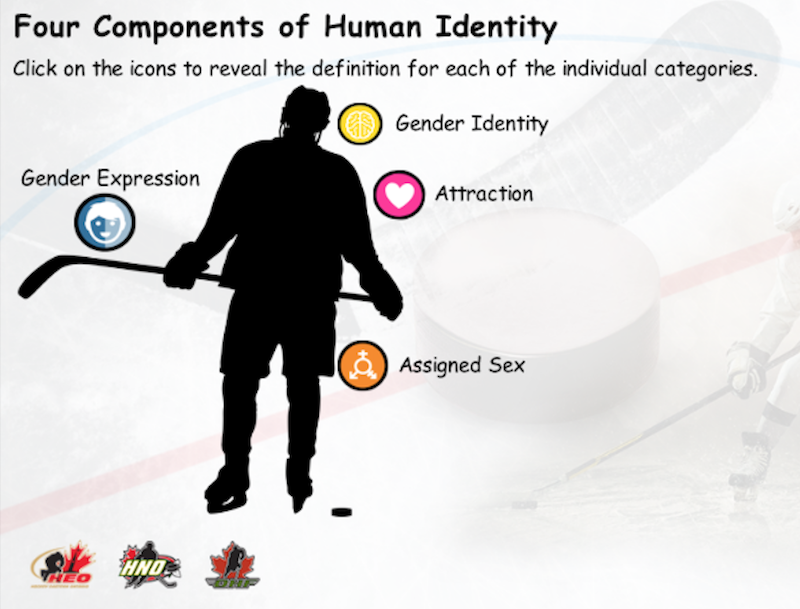
Slide 13.
Somewhat predictably, Egale instructs hockey officials that “pre-season chats are a great opportunity for everyone on your team, including coaches, assistant coaches and volunteers to share the name and gender pronoun by which they wish to be called.” But what irked Doe were the materials that went beyond practical advice, and instead comprised a sort of free-form gender-studies seminar full of fanciful and dubious claims.

Slide 18.
Several of the two dozen slides have nothing to do with hockey, but instead are devoted to the idea that “the gender binary…was imposed on Native societies…including on the land we now know as Canada.” These appear alongside maps showing the claimed transmission of the “gender binary” to the Americas, Africa and Australia from Europe. Later in the presentation, rank-and-file hockey moms and dads are informed that the term “Two Spirit” “seeks to restore traditional identities and roles that were actively buried by European Colonizers.”
On another slide, amid a parade of variously configured pink and blue male/female stick-people, the concept of “polygender” is introduced to define “people who identify as multiple genders simultaneously and can be several genders all at once. Or they may alternate between their varying gender identities depending on the day or the week.” Coaches also get a slide on “genderqueer” individuals, who exist in an undefined extra-dimensional gender space that allows them to “reject gender altogether”—though this is not to be confused with “agender” (it gets its own slide), a label that applies to those who are merely “genderless.” Later in the presentation, there are hockey-themed quizzes (“Drag and drop each puck in to the corresponding net”) to test coaches’ understanding of these rarified terms.
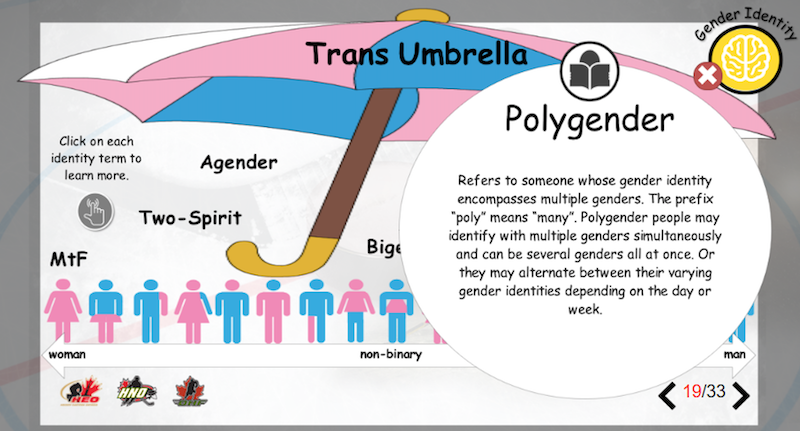
Slide 19.
All of this left Doe incredulous: “They’re putting this in a training course that’s mandatory for me to volunteer with my son?” Forwarding his concerns to Hockey Eastern Ontario, Doe requested a temporary exemption until he could explain his position to the organization more fully. According to documentation provided to Quillette, this request was denied, with Hockey Canada’s Senior Vice-President for Insurance and Risk Management writing to advise that these measures were mandatory under the aforementioned 2017 legal settlement. (The VP didn’t respond to my own requests for comment.)
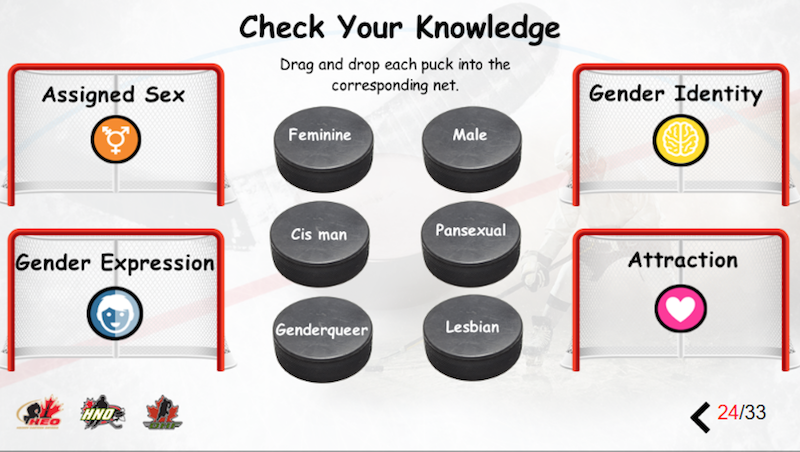
Slide 24.
Doe then wrote to Egale Canada and questioned the basis for some of the more far-fetched claims contained in the materials. He received a response from Jaclyn Isen, an Egale curriculum developer who implements “integrative anti-oppression education, human rights, diversity and inclusion, with a special focus on LGBTQI2S lives and experiences,” and who apparently served as a principal architect of the Tribunal-mandated training materials.
Unfortunately, Isen’s response was rendered in the somewhat arcane language typical of her gender-studies background. (In a 2015 paper, Rendering a Neighbourhood Queer, Isen and co-authors sought to use “collective mental mapping and photovoice renderings [to] interpret the queering of urban space as a queer utopian impulse.”) In response to Doe’s question about “polygender” kids who, Egale claims, can switch genders on a daily basis, for instance, Isen replied: “It is not outside the realm of possibility that the personal choice of what dressing room may feel the most comfortable and safest for any gender diverse person may shift over time as they navigate their own path toward affirming their identity while also navigating their own vulnerability to the possibility of transphobic harassment or bullying in those spaces.” (Isen did not respond to requests for comment.)
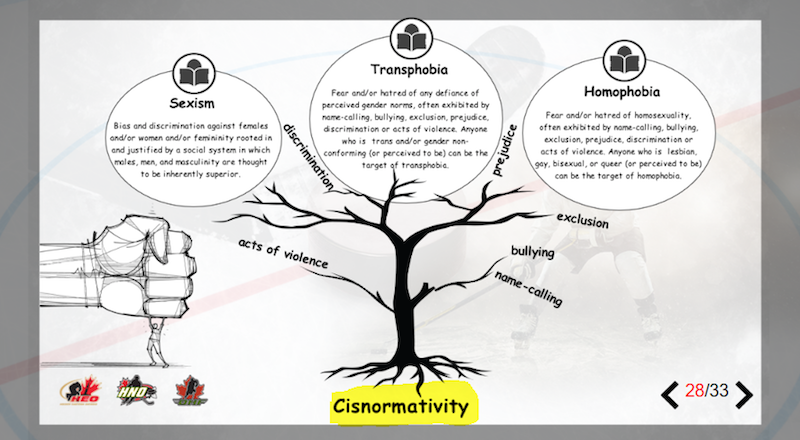
Slide 28.
On slide 28 of the Egale-authored materials, coaches are introduced to the concept of “cisnormativity”—which is illustrated with a sketched image of a person (presumably trans) seeking to avoid being crushed by a (presumably cis—i.e., non-trans) fist. After interacting with Hockey Canada and Egale fruitlessly, Doe concluded that the organizational priority had shifted from teaching kids hockey and making all feel welcome, to proselytizing a barely comprehensible gender typology. It had become clear that his days of coaching were effectively over: To even question these materials made a coach the human embodiment of that “cisnormative” fist.
“The more I looked into it [on the Internet], the more I saw that I wasn’t alone,” he adds. “There’s a lot of people speaking out and who are unhappy with how the activists are controlling the narrative around this.” Indeed, the outsourcing of such materials to Egale may be seen as a case study that illustrates how radicalized theories of gender have been mainstreamed in any number of organizations: At some point of legal or reputational crisis (in this case, corresponding to the resolution of a human-rights complaint), an organization’s leadership is pressured to adopt radical policies whose effects last indefinitely. And while the policies may not reflect the community served by the organization, anyone who objects does so at risk of prompting their own human-rights investigation.

Doe says he is actually sympathetic to Hockey Eastern Ontario’s position, and would be happy to see the organization fulfill its legal anti-discrimination obligations. But at the very least, he would like to see its instructional materials authored by people who are actually familiar with hockey culture, rather than academics reciting ideological boilerplate.
Unlike some of the other figures who are quoted on this subject in Quillette, Doe isn’t a “gender critical feminist,” or, indeed, any kind of professional cultural warrior. He’s just a father who refused to sign on to a propaganda document as a condition to help his son’s hockey team. And I suspect he won’t be the last.
Anna Slatz is a Canadian writer. Follow her on Twitter at @YesThatAnna.






